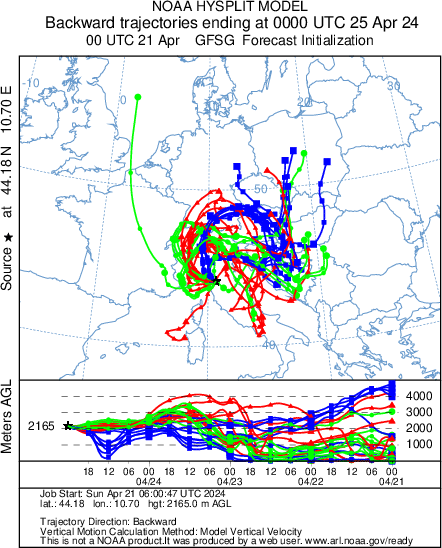Columnar ozone and nitrogen dioxide
Starting date: 1-8-1993
Status: Suspended
Instrumentation and calibration: Columnar ozone and nitrogen dioxide are carried out by zenith sky Differential Optical Absorption Spectroscopy (DOAS) by using a UV-Vis instrument of the GASCOD (Gas Analyser Spectrometer Correlating Optical Differences) family spectrometers. This type of instruments has been developed and set-up at the CNR-ISAC. GASCOD-MtC consists of: a Cassegrain objective (150 cm, F/#5) as a receiving optics combined with 10 mm × 2 μm input slit define the instrumental filed of view of 1.1E-5 sr; a specially designed holographic diffraction grating with 1200 l/mm providing sufficient spectral dispersion for detection of structured absorption features of the target gases. Spectral range available for exploration ranges from 250 nm to 900 nm detected by means of cooled CMOS diodes array consisting of 512 pixels within single sub-intervals of 60nm. In order to optimize CMOS exposure time an autoranging procedure is built-up within the instrument driving program ensuring enhanced S/N ratio. Ethernet link allows for the periodic downloading of the collected data. During the years, maintenance procedures have been carried out in such a way as to guarantee unchanged performance of the instrument, assuring the continuity of the data series. DOAS measurements do not require absolute calibration. GASCOD instruments participated in two NDSC (Network for Detection of Stratospheric Change) intercomparison campaigns. Project affiliation (s) Present: QUITSAT Past: TEMIS, QUILT, POLPO, ENVIREN Related research programmes
- Stratospheric chemistry
- Stratospheric NO2 trend studies
- Stratospheric-tropospheric exchange
- Greenhouse gases
- Long-range transport
- Satellite data validation
- Solar-terrestrial interactions
Why is this research important? The interplay between natural and anthropogenic factors influencing the Earth’s climate is extremely complex. Appropriate techniques for monitoring on a long-time scale of key stratospheric constituents are needed for reliable assessment of their impact on climate change. The evaluation of anthropogenic activities as climate forcing factors, as well as the evaluation of probability to trigger irreversible processes threatening human life, appear as key issues of atmospheric science. For this reason, ground-based DOAS monitoring of stratospheric minor gases firmly involved into ozone chemistry and ozone depletion processes is considered as a powerful tool providing valuable experimental data. Expected large extension of advanced satellite technologies aimed at observing the Earth from space during next years (e.g. Climate Change Initiative of ESA ) requires ground support for accurate satellite data validation. Particular attention is devoted to the GMES Sentinel missions designed for maintenance of systematic data set to be used as indicators of climate changes and their predictions through continuous monitoring of atmospheric chemistry, pollution, ozone content aerosols and other key atmospheric parameters. NO2 and O3 column measurements performed at Mt.Cimone are used for studies related to integration of ground-based and satellite observations aimed for evaluation of near surface pollution and air quality in Po valley.
Quick look Unfiltered NO2 total column time series obtained at Mt.Cimone by means of GASCOD-MtC instrument is shown in the figure below. NO2 seasonal cycle with maxima during summer period and minima during winter periods is well pronounced both for sunrise (blue) and sunset (orange) periods. The interruption from April’97 to July’98 is caused by technical reasons. Spread data towards higher values are consequence of tropospheric NO2 lightning production or influence of polluted air masses transported from Po valley above Mt.Cimone.
Organization (s): ISAC-CNR Via Gobetti 101, I-40129, Bologna www.isac.cnr.it
Contact persons: Dr. Ivan Kostadinov e-mail: i.kostadinov [at] isac.cnr.it, phone: +39 051 6399622/33>br> Dr. Andrea Petritoli e-mail: a.petritoli [at] isac.cnr.it phone: +39 051 6399584
Where can I find the data? by direct request to:i.kostadinov [at] isac.cnr.it, a.petritoli [at] isac.cnr.it



